On paper, MailChimp shouldn’t be a sexy company.
They’ve never raised venture capital.
They’re based in Atlanta, a world away from Silicon Valley.
Oh yeah, and their company helps businesses use everyone’s favorite marketing channel to hate—email.
But with 14 million customers, $400 million in revenue in 2016, and an intoxicating brand that gives even the biggest email curmudgeons the warm ‘n’ fuzzies, they’re not only a *very* sexy company—they’re a great example for any company that aspires to build a brand customers love.
Because of that, marketers have learned it’s worth paying attention to how and why MailChimp does the things they do.
So when they made a move last month that I believe will, long term, have a major impact on the entire landscape of email marketing tools, I figured it was worth paying attention to exactly what they’re doing.
I’m talking about the release of their new Facebook Ad Campaigns feature, which allows users to create, launch, and track Facebook ad campaigns within their MailChimp account with zero added cost.
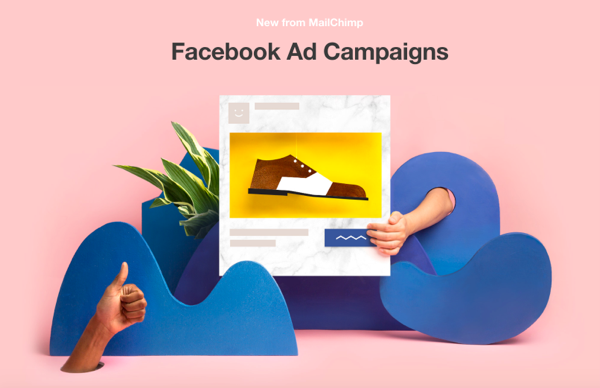
Pretty cool, right? If you’re a MailChimp user, you no longer have to try to make sense of Facebook’s ever-morphing ad manager interface.
But what’s really interesting are the long-term implications this move has for MailChimp as a company—and the subtle, yet major, ways MailChimp has already begun shifting their copy, positioning, and product.
The long-term implications are pretty clear to anyone who has seen the press MailChimp has gotten over the past few months.
For example, look at the subheadline of the article Fast Company wrote about the Facebook Ad Campaigns launch:

“…wants to be a one-stop shop for online marketing.”
Hmmmm…this might not be just another feature release.
Instead, it could be an early step toward an entire new identity for the nearly 17-year-old company.
TechCrunch’s Frederic Lardinois expanded on this further:
“MailChimp wants to become a holistic marketing platform for businesses (and I would expect that at some point in this process, it’ll change its name to reflect that).”
Whoa.
And finally, MailChimp CEO Ben Chestnut even told the New York Times that the company’s next phase is to become a “one-stop shop for the entirety of a small business’s marketing needs” in this fun read from Farhad Manjoo.
He also tweeted this when Fast Company named them one of the most innovative companies of 2017:
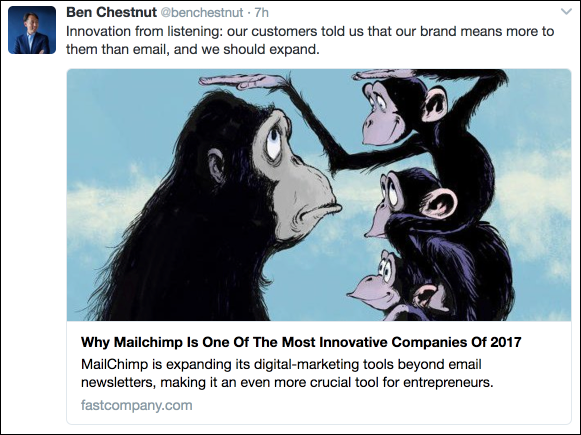
Whether you’re a MailChimp customer or not, if you have any experience with online marketing for small businesses, you know their brand is a giant in the market. Changing their name would be a huge deal!
That’s when it hit me—if this Facebook feature release is the first step in a brand-shifting move for MailChimp, it could present a fascinating opportunity to see how an extremely loved brand approaches a challenge many businesses must face at some point:
How do you evolve your company to reach more customers…without risking what’s made you successful in the first place?
Brand Repositioning: How Do You Do It Without Squandering Your Existing Market?
I may be talking about a business that brought in over $400 million last year, but brand repositioning isn’t a challenge that’s unique to big companies. There are early-stage startups and even single-person freelance operations that go through it all the time.
“I’m currently known for doing X, but doing Y is a huge growth opportunity. How do I pursue Y without losing X?”
How do you communicate that you now offer this shiny new thing…without alienating the people who love you for the old reliable thing you built your brand on?
MailChimp may still be years away from having more than just email as their central focus and core messaging, but there are three specific things they’ve already done that I think offer some lessons to any business wondering how to navigate the perils of repositioning:
- They made smart changes to their home page copy.
- They integrated the Facebook Ad Campaigns feature into their core product beautifully.
- They launched a bizarrely funny marketing campaign that perfectly fits their brand (and might just be the biggest hint of all of a massive change coming to the company).
In this post, I’m going to analyze how they’ve done all three and revealed what I think is a smart approach to brand repositioning.
We’ll start with #1, the home page.
1. MailChimp’s Biggest Headline Change in Over 5 Years
In June of 2013, this was MailChimp’s home page headline:
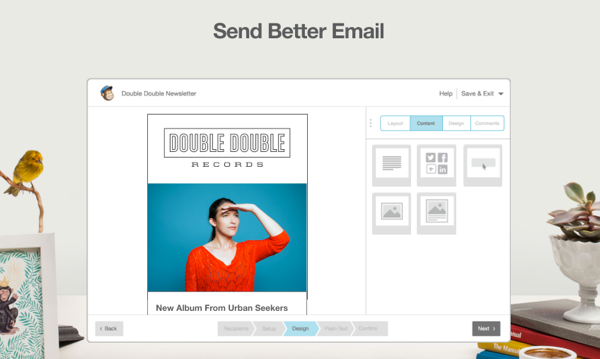
Send better email.
Simple, straightforward, and a promise that actually meant something to visitors since MailChimp had spent more than a decade building a reputation that backed it up.
Before “Send better email,” it had been something fairly similar for a few years: “Easy email newsletters”
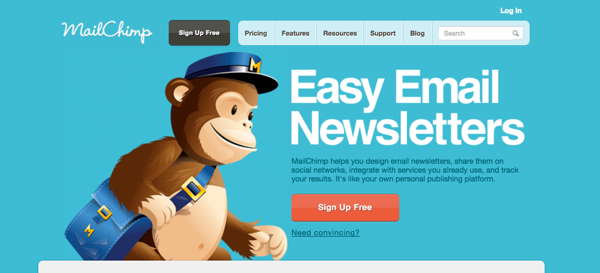
The bottom line? Since the company launched, its positioning had been 100% about email. (Big surprise for a company with “Mail” in the name, right?)
But in 2016, something changed. It would have been hard to notice immediately, but the first sign of brand repositioning appeared when they launched a feature called Product Recommendations—a second sentence joined the “Send better email” headline:
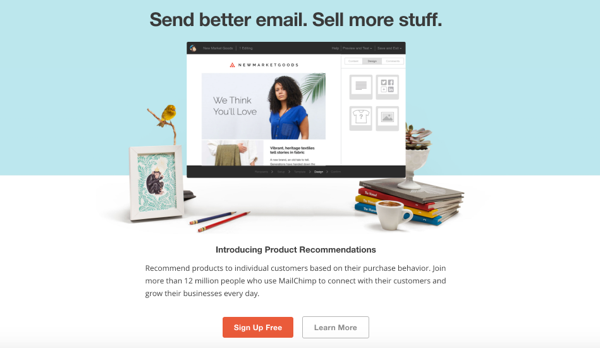
Send better email. Sell more stuff.
Not only is this the first headline to speak to something other than email, it’s the first specific mention of the benefit of increasing sales in their home page’s history that I can find. (And I’m a pretty deft user of the Internet Archive Wayback Machine. That’s right—deft.)
But if you look closer, you’ll notice this was more than just a headline change. They also showcased that brand new feature (Product Recommendations) in the home page’s primary CTA area.
Not coincidentally, Product Recommendations was a feature that tied directly into the “Sell more stuff” promise.
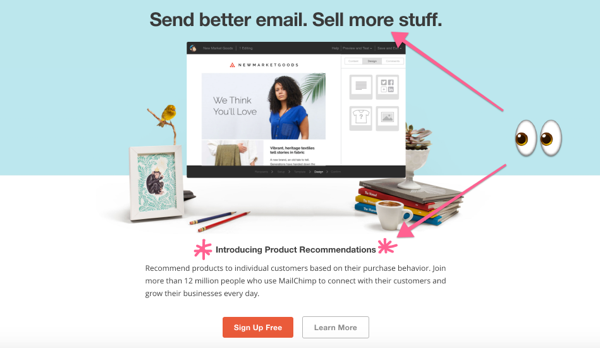
And if you look even closer, you’ll notice the way they describe what their customers use MailChimp to do aligns with the “sell more stuff” promise as well:

“Join 12 million people who use MailChimp to connect with their customers and grow their business every day.”
This is considerably different from how they described the way customers use MailChimp right before the feature launch and headline change:

“Join more than 10 million people who use MailChimp to design and send 600 million emails every day.”
Just like the old headline, it was only focused on sending email. It relied solely on their position as a market leader in email marketing to persuade visitors to sign up.
But now that they’re focusing on being known for more than just email, things become more complex—which is why they’ve made even bigger changes with the launch of the Facebook Ad Campaigns feature.
The home page’s job is now to educate visitors specifically on how it can help them grow. With more features, they’ve added more copy, including an entire section on how you can use MailChimp to sell more stuff:
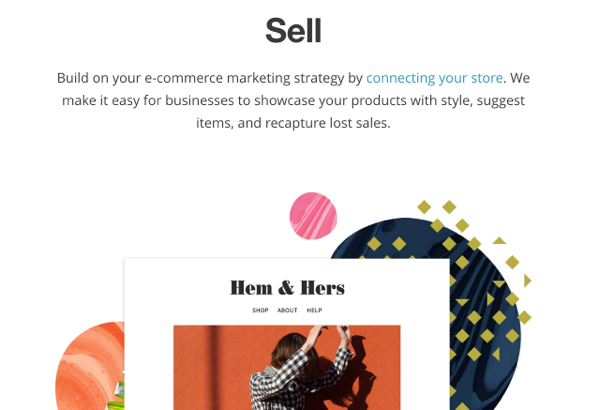
An entire section that doesn’t mention email—something that’s pretty unprecedented in the history of the company’s home page.
But the next section, which is dedicated to the new Facebook Ad Campaigns feature, makes an even bolder move:
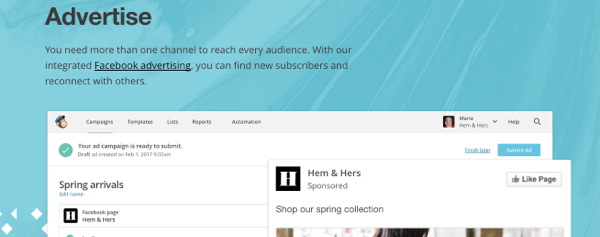
Look at that first line again. Do you see the bold move?
“You need more than one channel to reach every audience.”
For its entire history, MailChimp had focused on being the best at one channel—email. As we’ve seen, their copy has been singularly focused on it for over a decade.
But things have changed. While email is still the most effective way for most businesses to reach customers online, there are other great channels too. Rather than resisting the tides of change, MailChimp is grabbing a paddle.
They’re not only offering a tool to utilize another great channel (Facebook), they’re making sure small business owners know that focusing on only one channel isn’t even enough anymore.
This may seem like a minor addition, but when you consider how they’ve positioned themselves historically, it’s easy to see just how radically different this is for the company.
There are several other sections that provide details on MailChimp’s automation and analytics features, but I want to skip ahead to the page’s final call to action, which I think is pretty revealing:

“MailChimp gives you the marketing tools to be yourself on a bigger stage.”
They could have chosen to lead with a line like this, but they saved it for the end of the page. Why? Because they know there’s an endless number of SaaS platforms trying to position themselves as a suite of marketing tools that will help your business grow right now.
Rather than leading with that, MailChimp is still capitalizing on what makes them stand out—their position as a leader in email marketing.
That’s why this is still the first feature section of the page:
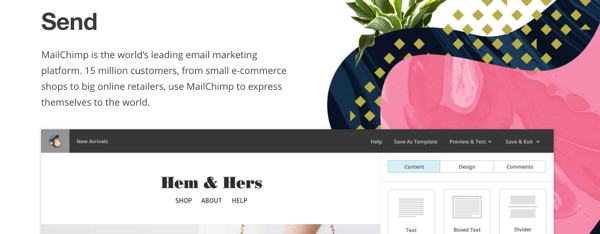
Before they tell you about all the fancy new features that will help your business grow, they lead with their bread and butter.
This is a theme that is echoed in the next phase of their smart, measured evolution—the way the Facebook Ad Campaigns feature is actually integrated into the product.
2. MailChimp Is Evolving Its Product Without Losing Its Familiarity
The introduction of Facebook Ad Campaigns (and simultaneous brand repositioning) could have been seen as an opportunity for MailChimp to completely rethink their user interface and experience.
They could have taken a big, bold step toward making users see them as an all-in-one marketing solution.
At the very least, they could have given Facebook advertising its own section in the app.
They didn’t do any of that.
The first time I logged in to check out the new feature, it took me a while to find it. First, I had to click the “Campaigns” tab:

One I was in my Campaigns dashboard, there still wasn’t anything about Facebook ads until I clicked the “Create Campaign” button and then clicked the “Campaign type” dropdown menu:
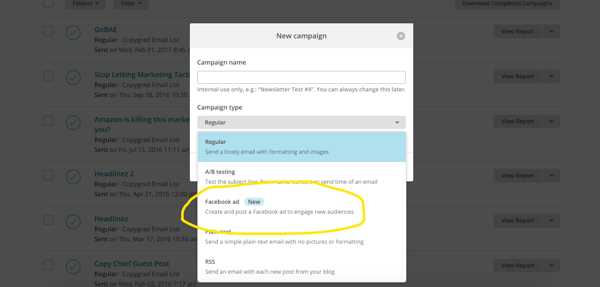
At first, I thought they’d kind of buried the feature. But then I realized that this was probably a smart idea for two reasons:
1. It’s in a familiar context.
Creating a Facebook ad can be intimidating, especially if it’s your first time. By putting the feature in the same area users create their email campaigns, they’ve made it way more approachable. It’s a subtle way of saying, “If you can create an email campaign in MailChimp, you can create a Facebook ad campaign too.”
2. Users will find it through regular habits.
Despite all the press and announcements made about the Facebook ads feature, the reality is that the majority of users still won’t know it exists. By placing it in what I’m guessing is the average user’s most frequent activity (creating an email campaign), they can discover it in a way that fits with their existing habits.
This is MailChimp’s way of changing without making users feel like they’re really changing.
The product is growing up, but it’s skipping those awkward teenage years so many tools go through—those times when it feels like a product is just throwing new features in your face and burying the stuff you actually use it for.
3. The Pretty Damn Weird, Perfectly MailChimpy Marketing Campaign That Assures You the Brand You Know and Love Will Endure (Despite a Little Repositioning)
I first noticed that something a weird was going on with MailChimp when I started seeing cryptic tweets like this one from their director of design:

When you click that link, you’re taken to a search results page on the MailChimp website for the term “failchips,” complete with an animation of chips raining down from the search bar:
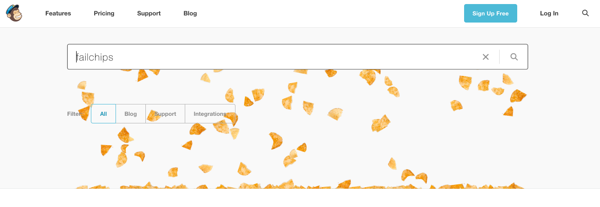
Then I stumbled upon this minute-long short film about a singing shrimp sandwich they’ve been promoting, titled MailShrimp:
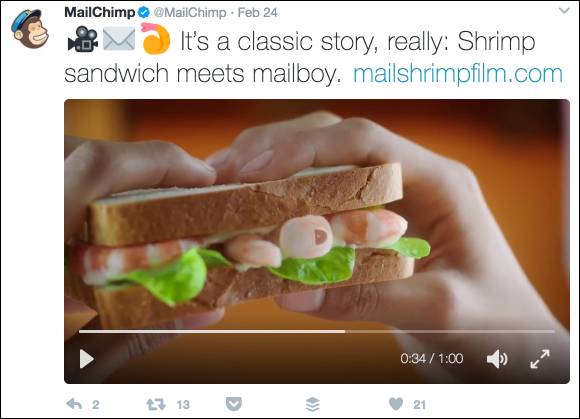
And last week I even got a notification that CEO Ben Chestnut had made a related addition to his Twitter bio (highlighted in green):

Once I paid another visit to their home page I started to get to the bottom of this.
At the top of the page, a slide-in banner appeared introducing the company with a rotating variety of other nonsensical names like:
- KaleLimp
- NailChamp
- WhaleSynth
- MaleCrimp
- and more
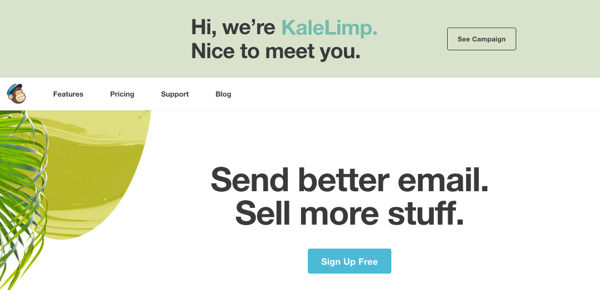
When you click on it, you go to a page that reveals more details about the marketing campaign. I underlined a few parts worth paying special attention:
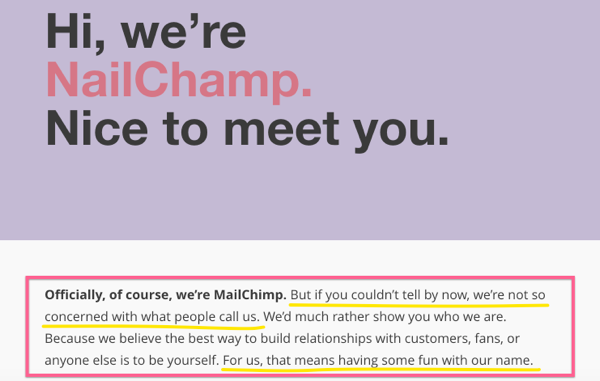
Okay, now we’re onto something!
There are three reasons I think MailChimp might have for basing an entire marketing campaign around poking fun at their name:
- They’re hinting that a name change is coming. (“…we’re not so concerned with what people call us.)
- They’re showing that their name doesn’t really define what they do anymore—that it’s more about their brand than the product itself. (Which would make sense if they’re planning on not changing the name even though they’re moving beyond email.)
- Or maybe it’s all just for fun and I’m reading too much into it. 🙂
UPDATE: Ben Chestnut let me know that a name change is not currently the plan:
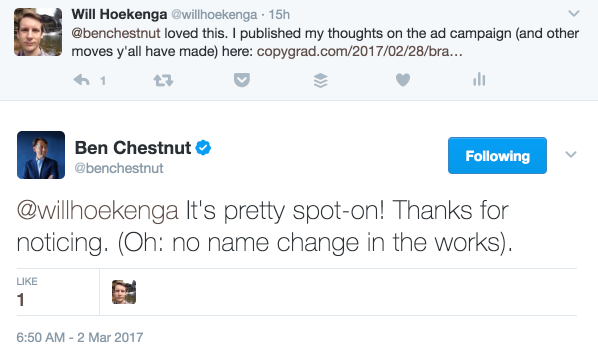
Regardless which of these reasons it turns out to be (or not be), I think what’s really at work here is the idea that the evolution of your business doesn’t have to be such a scary, uncomfortable thing.
Rather than leaving the process to a bunch of executives wringing their hands behind closed doors, MailChimp is letting their customers in on the process in a way that’s consistent with the fun, whimsical brand they’ve worked so hard to craft.
If they’re going to change their name, they’re ramping up to it in the most MailChimpy way possible!
I think it’s their way of telling customers that, ultimately, it doesn’t matter if the name changes or stays the same—they’ll still be the same company you’ve grown to love, whether they’re called MailChimp, MailShrimp, or something totally different.
The MailChimp Formula for Brand Repositioning the Smart Way
Other than showing you that I think MailChimp is going through a fascinating evolution right now, I want to point out a few lessons that I think are useful to anyone thinking of repositioning their brand:
1. You can evolve your product—and maybe even change your name—without changing the core of what makes you great.
Ask yourself—why do people love your product, brand, and company?
Are the things you just listed incompatible with the direction in which you’d like to move?
In most cases, I believe the answer will be no. The core of why your company exists often goes beyond the constraints of a single product.
MailChimp may have started out as a way for small business owners to easily send well-designed emails, but it’s become a lot more than that. They even pointed this out in the blog post announcing the Facebook Ad Campaigns feature:
“‘Our customers tell us that MailChimp helps them look pro and grow,’ says our CEO, Ben Chestnut. ‘It’s not an email platform, it’s not a newsletter tool—it’s the thing that helps them look more professional. That insight gave us a feeling of liberation. We don’t just have to do email. So we began talking to customers with that in mind.’”
Sure, there are probably practical reasons why people love your product (“It makes sending email really easy”), but there are also emotional ones (“It makes me look awesome”).
When you discover those emotional ones, you’ll find there’s often much more you could be doing to fulfill them.
2. Repositioning doesn’t have to happen in a single event—it can be a process.
It’s tempting to think you have to initiate big changes with a reset button.
A big, massive, all-at-once change seems like a good way to get attention. But it also risks alienating the customers who already know and love you.
Baby steps can be bold too. That’s why we freak out when babies take them!
There are ways to start small. Maybe it’s introducing a single new feature. Maybe it’s a change to the way you position yourself on your home page. Maybe it’s a shift in your content strategy.
That’s why I like the simple “Sell more stuff” addition to MailChimp’s headline. It clearly communicates where the product is going without abandoning what is still very much the core feature.
Like I said, MailChimp is probably still years away from becoming a legitimate “all-in-one” marketing solution for small business. But that doesn’t mean they can’t start steering the ship in that direction now.
You don’t have to leap without looking. Scorched earth-style changes are not required to be made to your copy.
3. You can let customers in on the process.
Once you’ve decided to reposition, don’t act like it’s a big secret!
Being open about the move is a great opportunity to let existing customers know you’re not abandoning them, while also letting the prospects you’re trying to attract know that you now provide the things they’re looking for.
The MailChimp blog post I mentioned earlier is a great example of this. Check out this paragraph:
“When we interviewed customers about what they wanted, they were clear: take the MailChimp magic to other marketing channels. ‘We listened, and that’s why we chose Facebook as our next marketing channel. After email, Facebook ads are the next most popular choice with our customers for acquiring customers and generating revenue,’ says Tom Klein, CMO.
‘We created an ad buying experience that feels like MailChimp, so customers can create beautiful ads quickly and get back to building their business.’ In just a few steps, you can create ads, set your targeting, and decide your budget. And if you’re already comfortable with MailChimp’s interface, you’ll feel right at home.”
If you’re open and transparent, you can get customers just as excited as your are. You can do this in a straightforward way (like the above paragraph), and in fun ways (like the MailShrimp campaign).
Let your customers inform the process and you might be surprised (and even delighted) at where they lead you.
Are these three brand repositioning lessons universally true?
Of course not.
The reasons brands have for repositioning aren’t always the same, and neither are the circumstances.
But I think they’re interesting guidelines to consider within the context of your business’s unique situation. Some may apply, some may not.
At the very least, they’ll get you asking questions worth answering.
On that note, what do you think of the steps MailChimp has taken so far, and what do you think other brands can learn from them? Perhaps most importantly, what will this mean for Freddie??? Drop a comment below and let’s chat about it.
